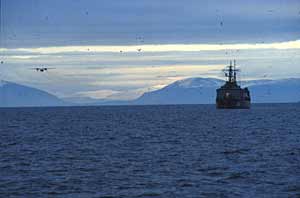Minatom is to continue subcritical nuclear testing this autumn at Novaya Zemlya in the Arctic. Funding shortfalls prevent Russia from a more frequent replacement of ageing plutonium in nuclear warheads.
Russian Ministry for Nuclear Energy, or Minatom, will be busy this autumn continuing its subcritical test program for nuclear weapons at Novaya Zemlya. The main purpose of the tests is believed to ensure that the lifetime of the old weapon grade plutonium stocks can be prolonged. The research of new generation weapons is also named as one of the reasons for testing.
Over the past two weeks, Minatom and Defence Ministry have carried out three tests, on August 28 and 31, and September 3. A spokesman from Minatom, Yury Bespalko, said that the amount of weapon-grade plutonium used in each test is around 100 grams, Gazeta.ru reported.
Yuri Bespalko said that plutonium of various ages was tested to establish whether it could perform well. Alexey Yablokov, chairman of the Russian Environmental Policy organisation, said he agreed with the official explanation. According to Yablokov, the behaviour of plutonium under various conditions is not known. The research conducted so far was mainly focused on the military aspects related to power output in order to increase the sufficiency of nuclear weapons. In the meantime, the ageing atoms of plutonium convert to americium-241. Yablokov said that the speed of the conversion is theoretically known, but the performance of plutonium-americium nuclear device is not being studied well enough. This might be the main purpose for Minatom to conduct the subcritical tests.
During the Soviet times plutonium was being replaced at all nuclear warheads each 6-10 years to ensure good performance of the devices. Today, the funding cut backs do not allow the same tempo of replacement even for the drastically reduced Russia’s nuclear weapon stocks. The number of warheads has been reduced from around 40,000 down to 10,000-12,000 during the past ten years.
The subcritical tests are aimed at verifying whether the possibility exists to prolong the service time of nuclear warheads and reduce the expenses.
Yablokov would not exclude that a part of the experiments may be used to improve and design new nuclear weapon devices.
Subcritical tests, or what Minatom calls them – hydrodynamic experiments, contain the ingredients of a nuclear warhead, plutonium or uranium, but fizzle out without any thermonuclear blast and, theoretically, are not accompanied by radioactive emissions.

The Comprehensive Test Ban Treaty (CTBT) does not prohibit subcritical tests – the fact that many of the signature countries to the treaty have criticised. This flaw in the CTBT allows countries like USA and Russia to continue research and development of new nuclear devises, making other countries nervous. Russia ratified CTBT on June 30, 2000.
Last winter, Russia carried out seven subcritical tests at Novaya Zemlya. A series of such tests was also conducted in September 1999. In 1998 five tests were carried out. The first time Russian authorities confirmed that they did indeed have a program for subcritical tests was back in 1997.
In September ten years ago, Bellona’s ship M/S Genius was protesting against the Soviet nuclear tests at Novaya Zemlya. The ship stayed outside the Russian territorial waters in the Barents Sea for three weeks.





